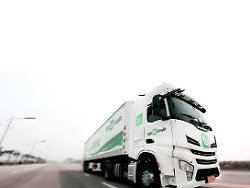Tuesday, December 21, 2021
Advantages over people
The use of self-driving trucks is getting closer
The interest of investors, manufacturers and haulage companies in self-driving trucks is increasing. The technology is by no means just a dream of the future: test fleets are already in use around the world. The industry sees its market maturity within reach.
The autonomous driving revolution is a long time coming for cars – it has long been here for trucks. Investors are betting that trucks without drivers will hit the streets first before cars will follow suit: Just a year ago, start-ups working on robotaxis raised eight times as much money as companies interested in self-driving trucks. In the meantime, the gap has narrowed dramatically. Because the use of the vehicles is getting closer.
The truck builders are primarily concerned with long-haul transport. “For us, the clear goal, not in Europe but in the USA, is to get driverless driving done,” said Daimler Truck boss Martin Daum. The company is cooperating with the US tech company Torc Robotics and the Google subsidiary Waymo on development and testing. A test fleet has been on the highways in the southwest of the USA for around three years, for example in the desert of New Mexico, in order to collect data for a technology that is ready for series production.
The Volkswagen commercial vehicle subsidiary Traton is testing its trucks in Sweden, where Scania vehicles are already driving autonomously over a 300-kilometer route, albeit with a safety driver on board. Tests on the autobahn should also start in Germany. “The big hit will be when the truck can drive independently and without a safety driver on board,” said Andreas Kammel, who is responsible for the strategy for autonomous driving and alternative drives at Traton. “Autonomous driving has to be significantly safer than the human factor.”
Big promises
The company, which also owns the US brand Navistar, is working with Tusimple in this area. The head of the US technology company, which went public in April and has a market valuation of $ 8.5 billion, warned against overly optimism. “We are very aware that the industry has made too big promises,” said Cheng Lu. “She now understands how complex it is and that it will take even longer to find a solution.” Longer – that is, until around the middle of the decade. Then the 100 Navistar trucks with Tusimple technology, which DHL has ordered in the USA, will be delivered.
Traton expert Kammel also points out regulatory hurdles. A revision of various international rules is planned for 2024 and 2025 – “that is, a legal framework could be in place in 2025 that allows broad use if the technology meets the strict safety requirements.” Whether the technology works also depends on the environment in which the trucks are supposed to move. The more narrowly the application is defined, the sooner it could work, says Kammel. “If we say, for example, we want to drive on a snow-covered country road, it will probably not be so far for the next decade.” In perspective, however, this is also solvable.
Opposite of a “testosterone-charged man”
In any case, an autonomous vehicle practices a defensive driving style. It will always slow down when it encounters a “testosterone-charged man”, said Ralf Klaedtke, chief technician at the sensor experts TE Connectivity. “The autonomous vehicle will always be the slowest in mixed traffic.” For the truck builder, the following applies: They want to jump from automation level two, i.e. already common assistance systems, to level four, the truck without a person at the wheel. That means “exponentially higher security challenges,” said Daum.
The background to this is the shortage of drivers, which is a problem for freight forwarders around the world – and the cost argument. For companies, driver wages are one of the largest cost items. Driverless trucks are likely to be more expensive than conventional vehicles, and many companies are likely to charge a monthly fee for the autonomous services – but the bottom line is that the freight forwarders should still save, especially since the algorithm does not need any breaks and drives until the battery or the fuel is all.
But not only the long haul is an area of application for self-driving trucks. Some autonomous trucks are already in use in demarcated areas, for example in the port of Hamburg or in a mine in Australia. The automotive supplier ZF recently agreed a strategic partnership with the Swiss company Embotech, which is primarily focused on maneuvering solutions. “Already now, the use in closed areas offers added value for various applications,” says Embotech boss Andreas Kyrtatos. “This applies to end customers in many industries – be it a vehicle manufacturer, a logistics company that transports containers from a factory to an inland port, or a mining company that covers long distances with autonomous tippers.”
